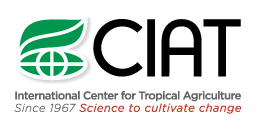Genome editing in rice: As simple as cut and paste?
It’s a technique that’s still in its infancy, but genome editing offers promising new ways to boost the productivity and nutritional value of food crops.
It involves cutting, copying and pasting molecules in a plant’s genome sequence to change the plant’s characteristics. CIAT has been testing the technique with rice, using a technology called CRISPR, which has taken the world of molecular biology by storm since it came to light in 2012. CRISPR uses an enzyme called Cas9 that enables scientists to home-in on target areas of DNA and make the required edits. Compared to other gene editing techniques, CRISPR is extremely cost-effective.
Scientists led by Paul Chavarriaga of the Center’s Genetic Transformation Platform used CRISPR to create a “drooping leaf” effect in IR64, a rice variety developed by its CGIAR sister center, the International Rice Research Institute (IRRI). Scientists in Japan have already performed the same feat with Japonica rice. IR64 has been used to improve hundreds of rice varieties, which have been released in a dozen countries and are grown on millions of hectares. If genome editing for important agronomical traits could give more of an edge to this already superior rice, the benefits would reach many millions of people.
 When the drooping leaf trait is switched on, the plant’s normally pert leaves appear limp. It’s a useful visual indicator of whether the gene editing technique has been successful.
When the drooping leaf trait is switched on, the plant’s normally pert leaves appear limp. It’s a useful visual indicator of whether the gene editing technique has been successful.
With the concept now proven in IR64, Chavarriaga and his team hope it can be applied to other parts of the rice genome to “switch” traits on or off. And the options don’t stop at rice. One possibility is to boost the nutritional value of staple food crops like cassava, by enhancing the presence of beta-carotene, the precursor of Vitamin A. Another is to help boost the crop’s resistance to bacterial or viral diseases or modify starch quality in roots.
There are so many opportunities for speeding up the rate of crop improvement using gene editing. The beauty is that the raw material – the genetic information – is already there in the plants; we just need to activate or deactivate them.
Paul Chavarriaga
CIAT scientist Sandra Valdés is preparing a note on this development, which will hopefully be CIAT’s first contribution to the growing scientific literature on genome editing. In this work, Valdés is collaborating with Japan’s National Institute of Agrobiological Sciences (NIAS) and the University of Melbourne in Australia. NIAS scientists Masaki Endo and Seiichi Toki spent two weeks in CIAT in 2015, training scientists including Valdés on gene editing technology for rice. This is part of CIAT’s long-term collaboration with NIAS for the genetic improvement of the crop.

